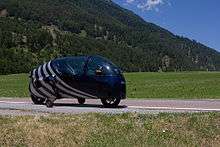Ecomobile
The Ecomobile is a cabin motorcycle of by Peraves AG, made in Winterthur Switzerland since 1984.

History
Arnold Wagner of Switzerland received a patent in 1983 for a support device for a single-track vehicle, a requirement for cabin motorcycles, for which he also received a patent in 1984.[1][2]
ECO
The first vehicles were manufactured in 1984 under the name "Oemil" (OEkoMobIL) or "Peraves Oemil" with a BMW R 100 engine through S/N 5003, and a BMW K 100 offered after that. Since Peraves wanted to avoid confusion with the eco-movement, the "OEkoMobIL" in "Ecomobile" was renamed "ECO" (internal name W18 K5). By 2005, 91 ECOs powered by BMW K-type engines had been manufactured.
MonoTracer
In 2006, the MonoTracer was released, using BMW K 1200 RS engines; individual specimens with turbocharging and up to 190 hp are said to have reached a top speed of 315 km/h. 58 MonoTracers were built, of which 12 were made with electric drive, called MonoTracer-MTE-150.[3] In 2010, the two prototypes of the MonoTracers MTE (also called X-Tracer) won the $ 2.5 million X-Prize with far the best efficiency of > 200 mpg-e equivalent consumption 1.1 litres of gas per 100 km.
From 2009, vehicle production had been partly outsourced to the joint venture Bohema Mobil and Peraves CZ in Brno-Medlanky (Czech Republic). In October 2014, Peraves AG filed for bankruptcy and was dissolved.
The technology will continue to be offered (as of 2016) from the Czech Republic. For trademark reasons, the vehicle was renamed MonoTracer Monoracer. At the end of 2016, the production of the gasoline-powered model was to be discontinued and, from 2017, only a battery-electric variant would be offered.
Construction
3.65 m long, 1.52 m high, and 1.25 m wide MonoTracer with a curb weight of 485 kg sitting driver and passenger secured by three-point belts in a row. Streamlined optimized vehicle body consists of aramid fiber reinforced plastic with laminated steel tube or cast aluminum reinforcement parts. In the rear of the vehicle is a luggage area. The aerodynamic drag coefficient is low due to the streamlined structure (cda value of 0.19) and the small face area (≈ 1 m²). With the engine of the BMW K 1200 RS (85 kW), a top speed of over 240 km / h is achieved. The fuel consumption is given at constant 90 km / h with 3.6 litres and at 120 km / h with 4.4 litres per 100 km.
In order to make the concept of the closed cab possible, hinged support wheels are mounted on both sides. These are lowered or raised by a switch on the handlebars. To prevent false actuation, such as stalling or under-speeding, or inadvertent deployment at high speeds, a computer system blocks such actuation errors as a function of speed and lateral acceleration. The driver will be alerted by green lights indicating possible lifting or lowering. If the supports, which require about 0.5 seconds to extend, are not extended at walking speed, a warning tone will sound. If the driver does not respond with lowering, the vehicle tilts on its side while stationary. The retracted support wheels catch the fall softly and the vehicle takes no damage. In fast corners, with an inclination of 52 to 55 degrees, it is possible to bring the retracted, inner-curve support wheels on the ground and to negotiate the curve on three wheels.
The drive is purchased from BMW. It comes from the four-cylinder motorcycle series BMW K 100 (Ecomobile) and BMW K 1200 RS (MonoTracer) and makes between 90 and 130 hp. The five-speed motorcycle transmission has been modified to give the driver four forward gears and one reverse gear. MTE electric vehicles are powered by Brusa or AC Propulsion MTE engines.
Licensing
For driving license purposes, the Ecomobile / MonoTracer treated by governments as a motorcycle. Driving the ECO or the MonoTracers requires a Class A driver's license. Driving such a cabin motorcycle requires some training. In particular, the driver must be aware that due to vehicle's smaller size, they may not be perceived by drivers as readily as other, larger vehicles.
Weblinks
References
- EP0097623 A1 (retrieved on 2 April 2015)
- EP 0097622 A1 (retrieved on 2 April 2015)
- spiegel.de Peraves Monotracer (retrieved 2 April 2015)